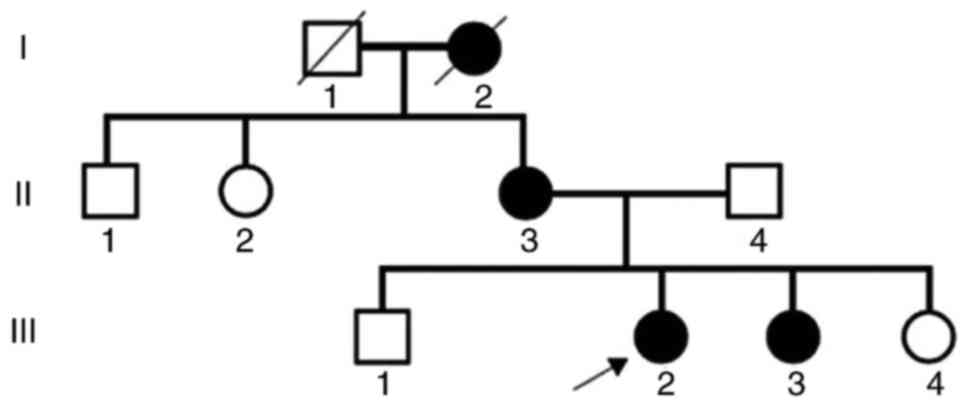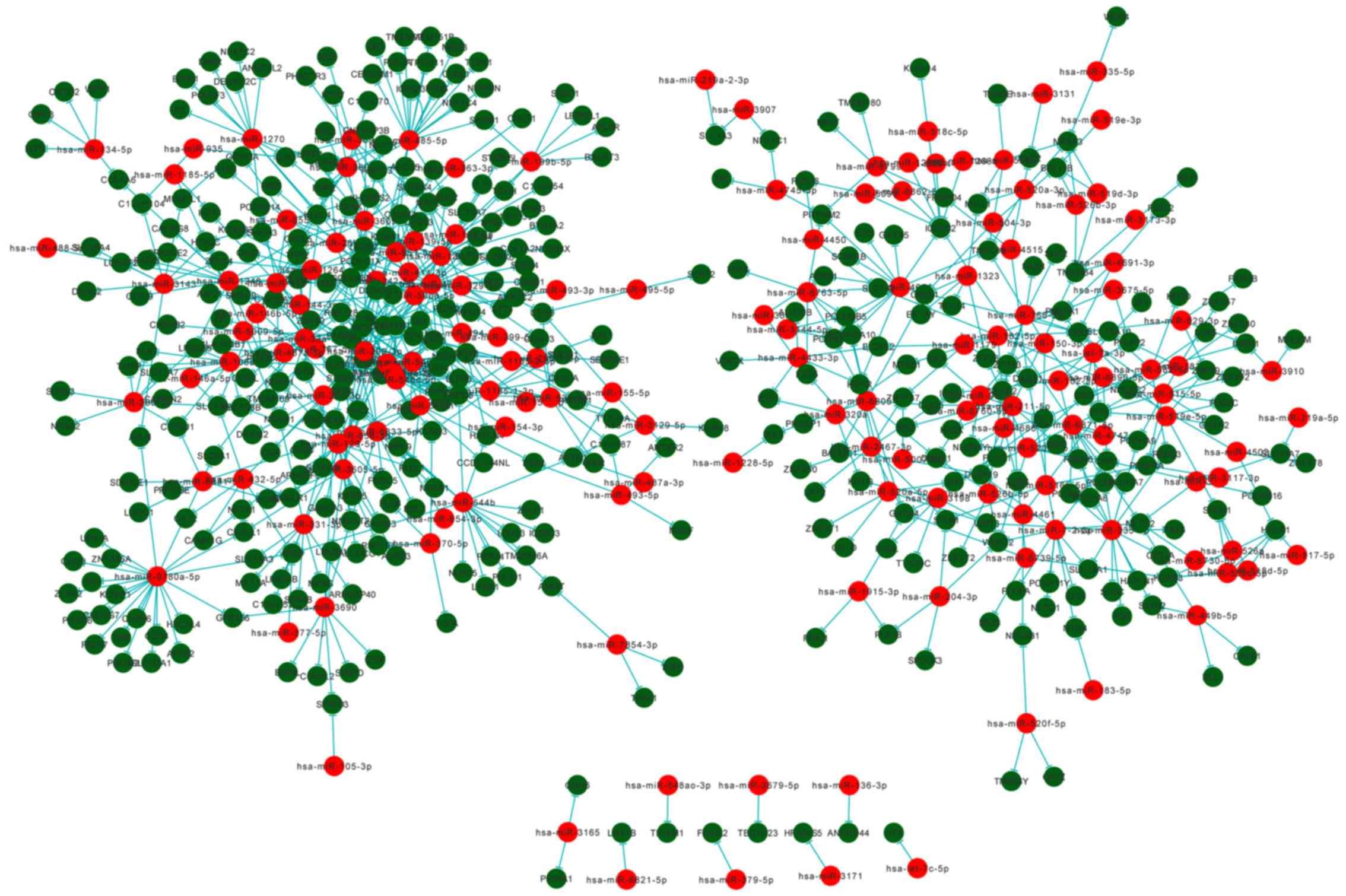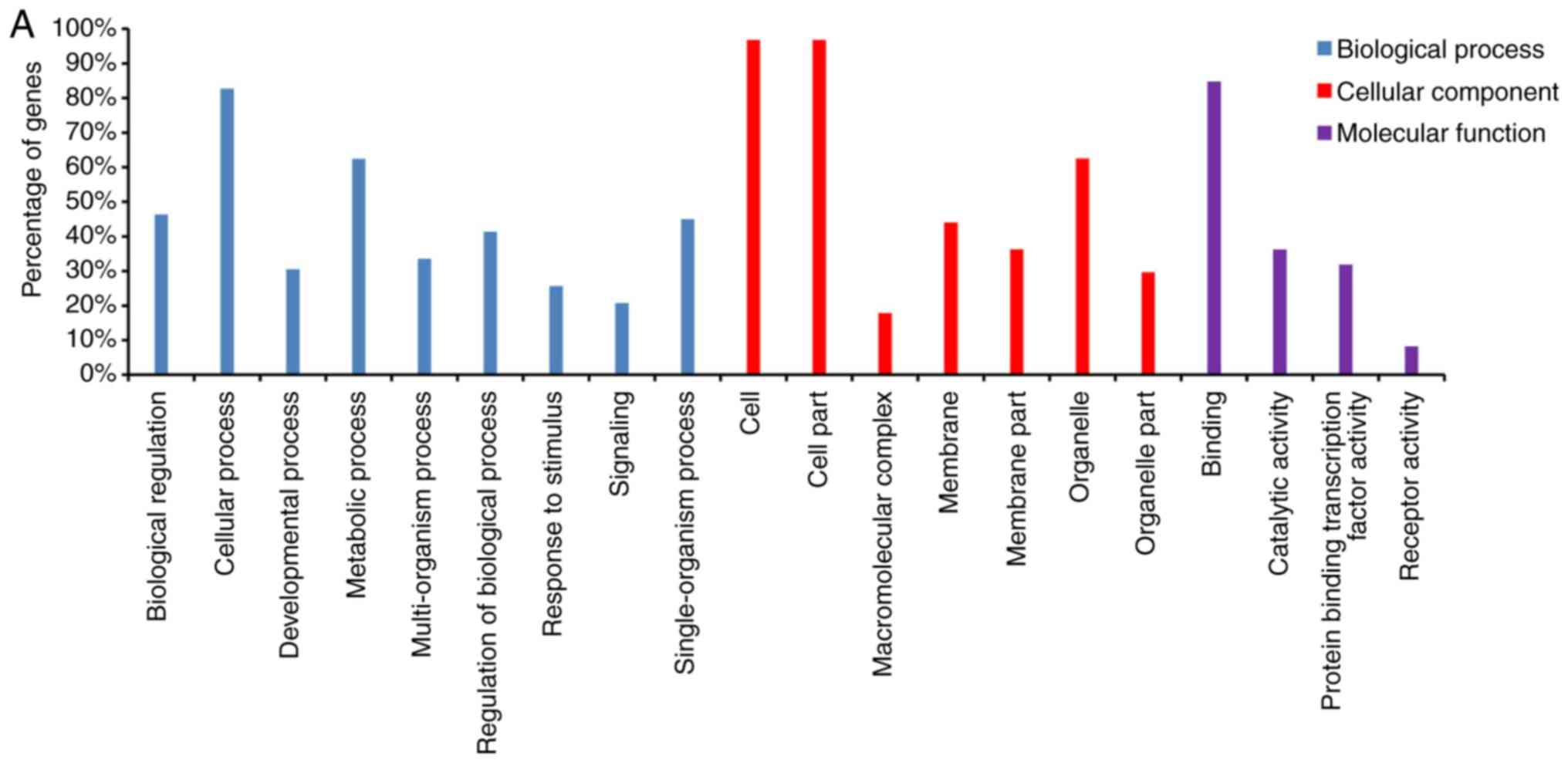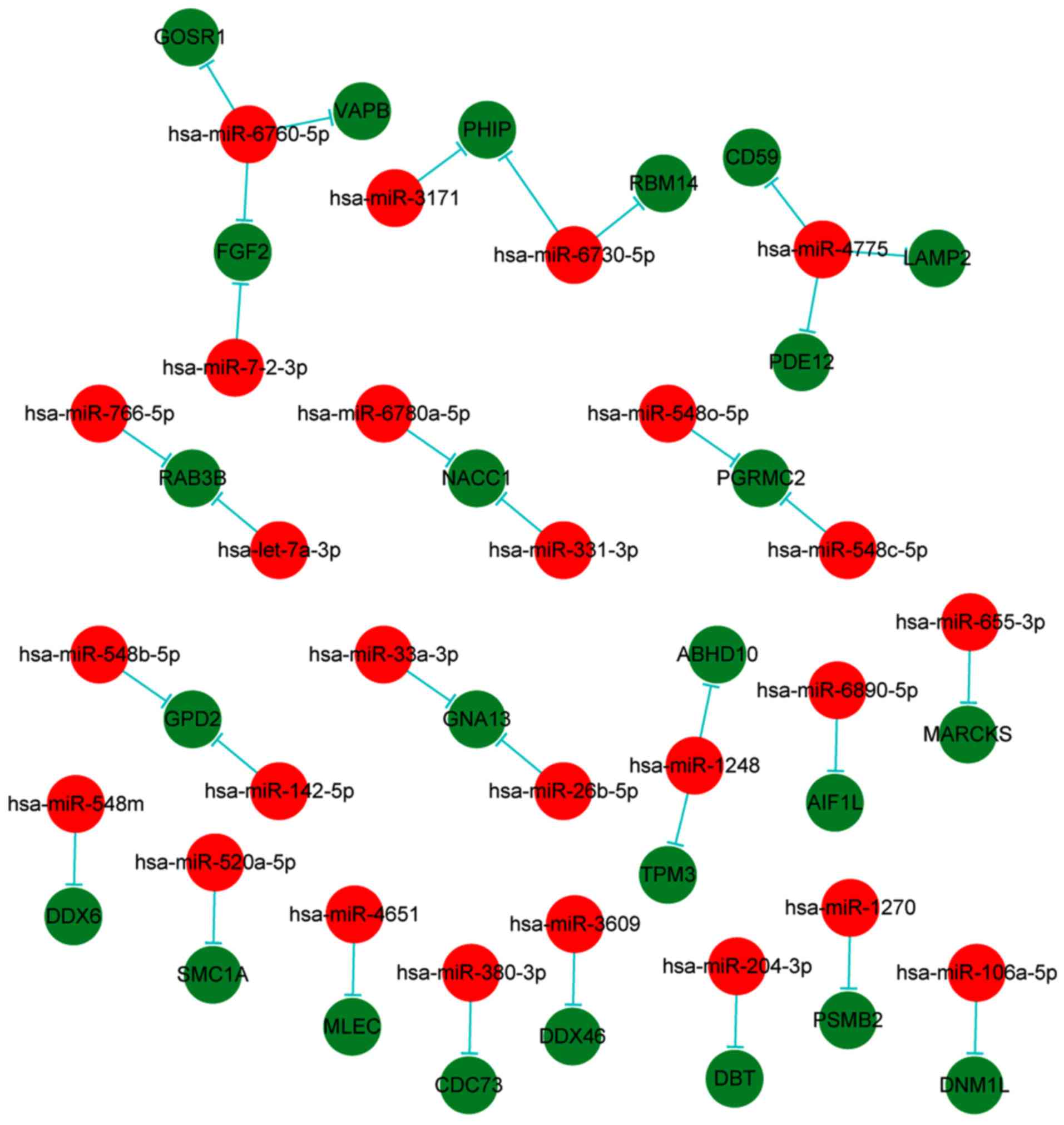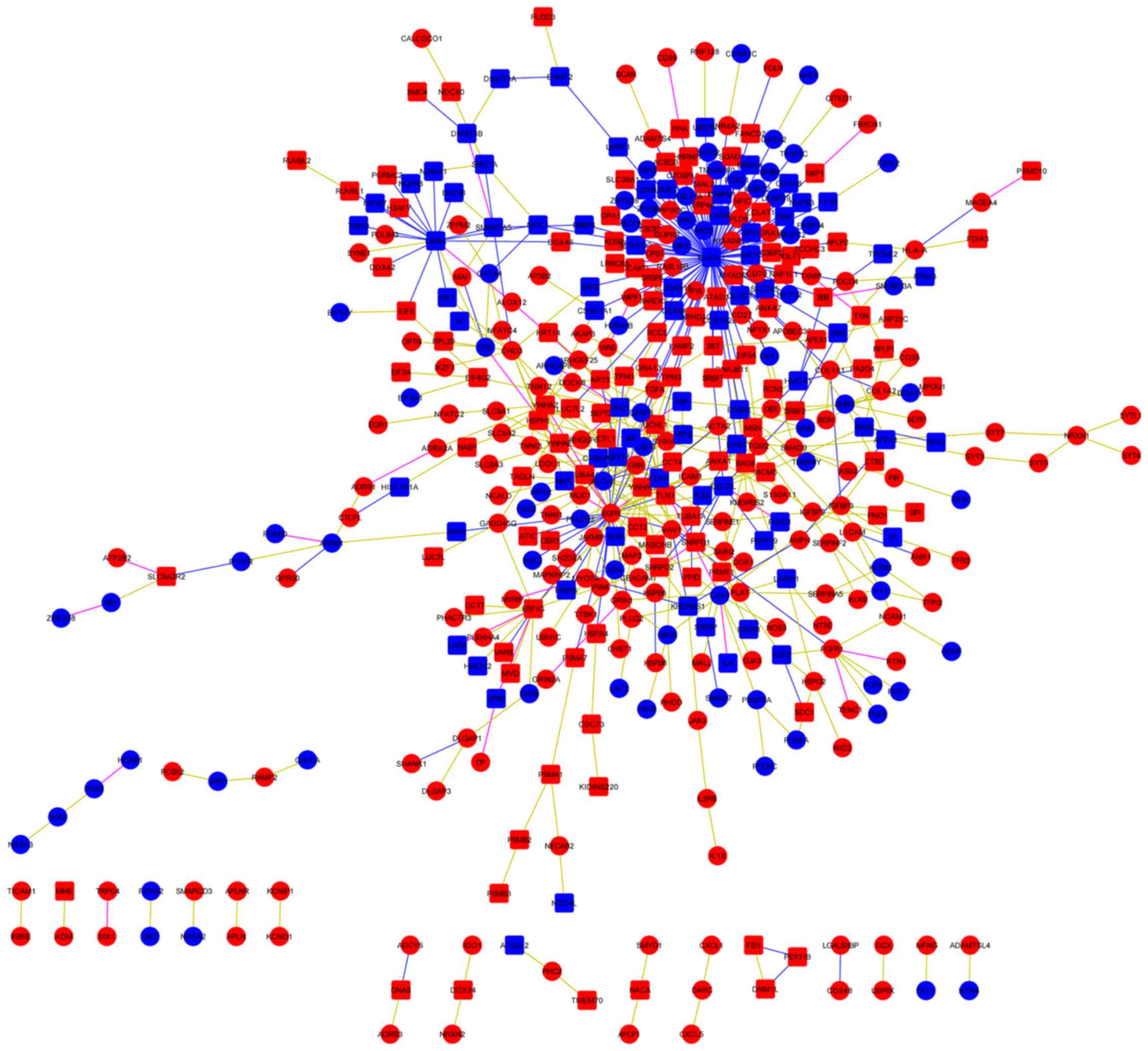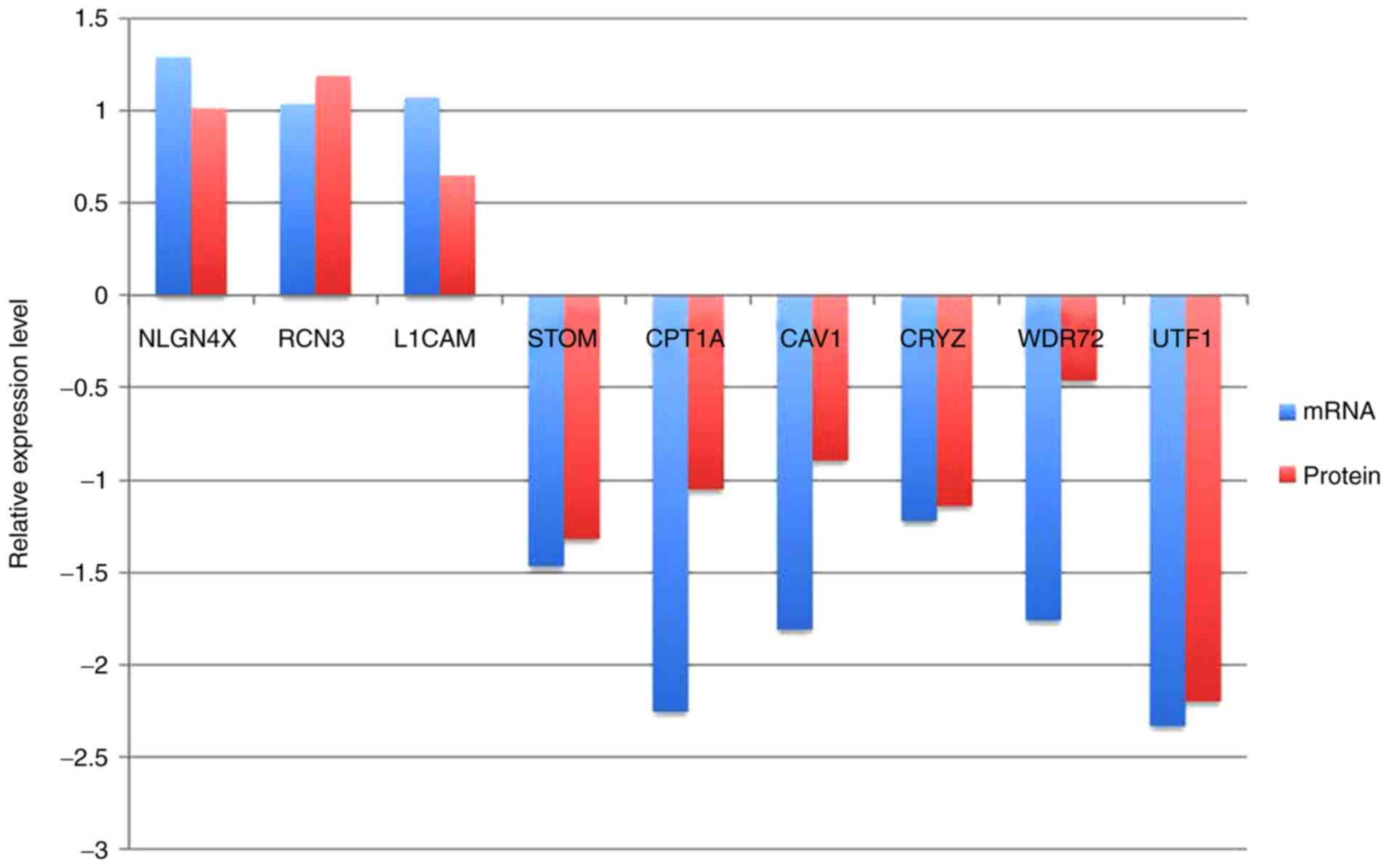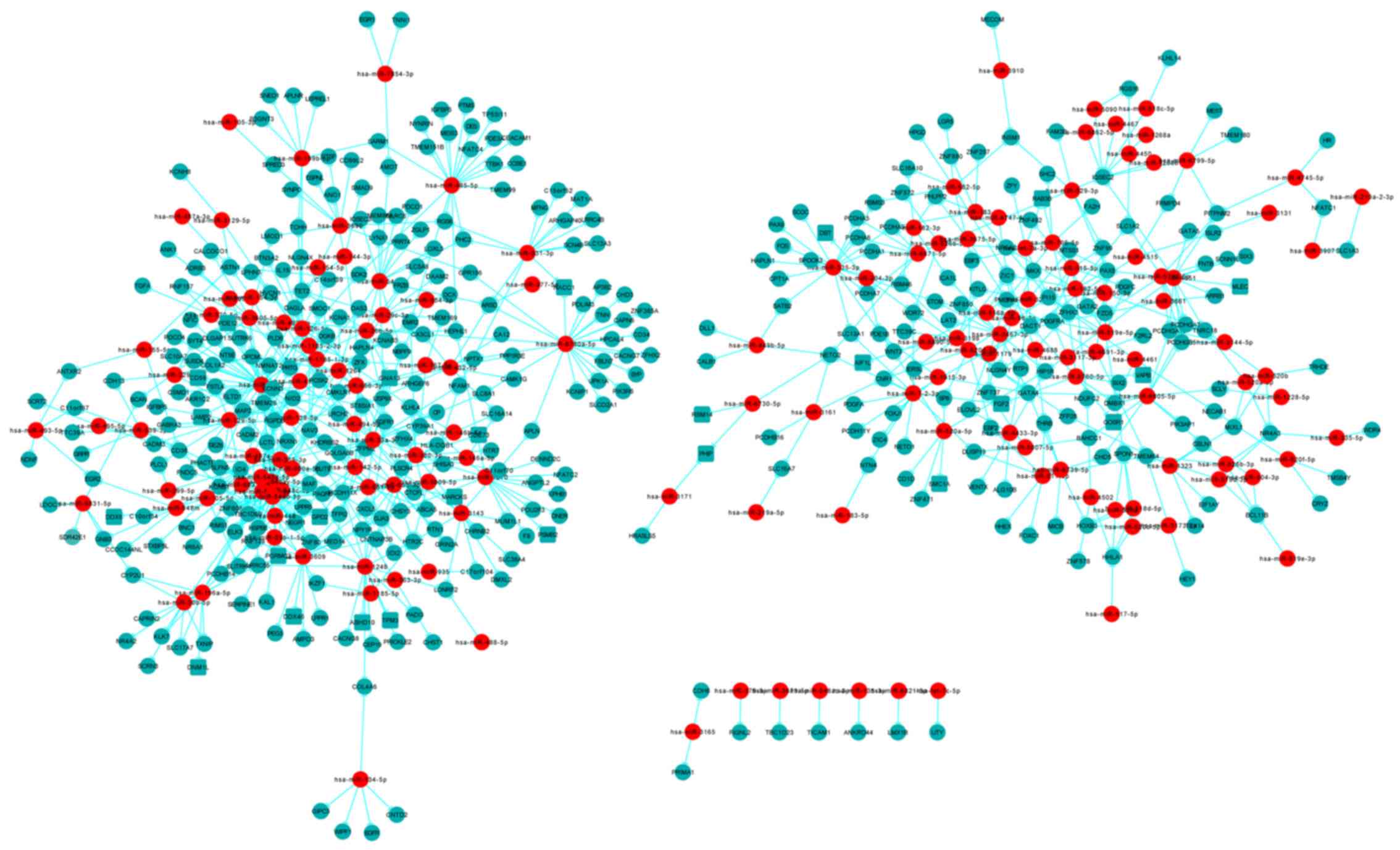|
1
|
Heidet L and Gubler MC: The renal lesions
of Alport syndrome. J Am Soc Nephrol. 20:1210–1215. 2009.
View Article : Google Scholar : PubMed/NCBI
|
|
2
|
Kruegel J, Rubel D and Gross O: Alport
syndrome-insights from basic and clinical research. Nat Rev
Nephrol. 9:170–178. 2013. View Article : Google Scholar : PubMed/NCBI
|
|
3
|
Endreffy E, Ondrik Z, Ivanyi B, Maróti Z,
Bereczki C, Haszon I, Györke Z, Worum E, Németh K, Rikker C, et al:
Collagen type IV nephropathy: Genetic heterogeneity examinations in
affected hungarian families. Mol Cell Probes. 25:28–34. 2011.
View Article : Google Scholar : PubMed/NCBI
|
|
4
|
Thorner PS: Alport syndrome and thin
basement membrane nephropathy. Nephron Clin Pract. 106:c82–c88.
2007. View Article : Google Scholar : PubMed/NCBI
|
|
5
|
Haas M: Alport syndrome and thin
glomerular basement membrane nephropathy: A practical approach to
diagnosis. Arch Pathol Lab Med. 133:224–232. 2009.PubMed/NCBI
|
|
6
|
Miao Y, Xiong J, Zhang X, Huang H, Yu L,
Chen J, Deng W, Xu H, Liu R, Xiang C, et al: Genetic diagnosis of
polycystic kidney disease, Alport syndrome, and thalassemia minor
in a large Chinese family. Clin Sci (Lond). 131:2427–2438. 2017.
View Article : Google Scholar : PubMed/NCBI
|
|
7
|
Weber S, Strasser K, Rath S, Kittke A,
Beicht S, Alberer M, Lange-Sperandio B, Hoyer PF, Benz MR, Ponsel
S, et al: Identification of 47 novel mutations in patients with
alport syndrome and thin basement membrane nephropathy. Pediatr
Nephrol. 31:941–955. 2016. View Article : Google Scholar : PubMed/NCBI
|
|
8
|
Nozu K, Vorechovsky I, Kaito H, Fu XJ,
Nakanishi K, Hashimura Y, Hashimoto F, Kamei K, Ito S, Kaku Y, et
al: X-linked Alport syndrome caused by splicing mutations in
COL4A5. Clin J Am Soc Nephrol. 9:1958–1964. 2014. View Article : Google Scholar : PubMed/NCBI
|
|
9
|
Lin X, Suh JH, Go G and Miner JH:
Feasibility of repairing glomerular basement membrane defects in
alport syndrome. J Am Soc Nephrol. 25:687–692. 2014. View Article : Google Scholar : PubMed/NCBI
|
|
10
|
Guo Y, Yuan J, Liang H, Xiao J, Xu H, Yuan
L, Gao K, Wu B, Tang Y, Li X and Deng H: Identification of a novel
COL4A5 mutation in a Chinese family with X-linked Alport syndrome
using exome sequencing. Mol Biol Rep. 41:3631–3635. 2014.
View Article : Google Scholar : PubMed/NCBI
|
|
11
|
Kim VN and Nam JW: Genomics of microRNA.
Trends Genet. 22:165–173. 2006. View Article : Google Scholar : PubMed/NCBI
|
|
12
|
Ghosh Z, Chakrabarti J and Mallick B:
miRNomics-the bioinformatics of microRNA genes. Biochem Biophys Res
Commun. 363:6–11. 2007. View Article : Google Scholar : PubMed/NCBI
|
|
13
|
Chung AC, Yu X and Lan HY: MicroRNA and
nephropathy: Emerging concepts. Int J Nephrol Renovasc Dis.
6:169–179. 2013.PubMed/NCBI
|
|
14
|
Chen W, Lin X, Huang J, Tan K, Chen Y,
Peng W, Li W and Dai Y: Integrated profiling of microRNA expression
in membranous nephropathy using high-throughput sequencing
technology. Int J Mol Med. 33:25–34. 2014. View Article : Google Scholar : PubMed/NCBI
|
|
15
|
Tan K, Chen J, Li W, Chen Y, Sui W, Zhang
Y and Dai Y: Genome-wide analysis of microRNAs expression profiling
in patients with primary IgA nephropathy. Genome. 56:161–169. 2013.
View Article : Google Scholar : PubMed/NCBI
|
|
16
|
Dai Y, Huang YS, Tang M, Lv TY, Hu CX, Tan
YH, Xu ZM and Yin YB: Microarray analysis of microRNA expression in
peripheral blood cells of systemic lupus erythematosus patients.
Lupus. 16:939–946. 2007. View Article : Google Scholar : PubMed/NCBI
|
|
17
|
Hafner M, Landthaler M, Burger L, Khorshid
M, Hausser J, Berninger P, Rothballer A, Ascano M Jr, Jungkamp AC,
Munschauer M, et al: Transcriptome-wide identification of
RNA-binding protein and microRNA target sites by PAR-CLIP. Cell.
141:129–141. 2010. View Article : Google Scholar : PubMed/NCBI
|
|
18
|
Woroniecka KI, Park AS, Mohtat D, Thomas
DB, Pullman JM and Susztak K: Transcriptome analysis of human
diabetic kidney disease. Diabetes. 60:2354–2369. 2011. View Article : Google Scholar : PubMed/NCBI
|
|
19
|
Famulski KS, Broderick G, Einecke G, Hay
K, Cruz J, Sis B, Mengel M and Halloran PF: Transcriptome analysis
reveals heterogeneity in the injury response of kidney transplants.
Am J Transplant. 7:2483–2495. 2007. View Article : Google Scholar : PubMed/NCBI
|
|
20
|
Kapoor I, Pal P, Lochab S, Kanaujiya JK
and Trivedi AK: Proteomics approaches for myeloid leukemia drug
discovery. Expert Opin Drug Discov. 7:1165–1175. 2012. View Article : Google Scholar : PubMed/NCBI
|
|
21
|
Raimondo F, Corbetta S, Morosi L, Chinello
C, Gianazza E, Castoldi G, Di Gioia C, Bombardi C, Stella A,
Battaglia C, et al: Urinary exosomes and diabetic nephropathy: A
proteomic approach. Mol Biosyst. 9:1139–1146. 2013. View Article : Google Scholar : PubMed/NCBI
|
|
22
|
Park MR, Wang EH, Jin DC, Cha JH, Lee KH,
Yang CW, Kang CS and Choi YJ: Establishment of a 2-D human urinary
proteomic map in IgA nephropathy. Proteomics. 6:1066–1076. 2006.
View Article : Google Scholar : PubMed/NCBI
|
|
23
|
Ebert AD, Liang P and Wu JC: Induced
pluripotent stem cells as a disease modeling and drug screening
platform. J Cardiovasc Pharmacol. 60:408–416. 2012. View Article : Google Scholar : PubMed/NCBI
|
|
24
|
Hirschi KK, Li S and Roy K: Induced
pluripotent stem cells for regenerative medicine. Annu Rev Biomed
Eng. 16:277–294. 2014. View Article : Google Scholar : PubMed/NCBI
|
|
25
|
Qian K, Huang CT, Chen H, Blackbourn LW
IV, Chen Y, Cao J, Yao L, Sauvey C, Du Z and Zhang SC: A simple and
efficient system for regulating gene expression in human
pluripotent stem cells and derivatives. Stem Cells. 32:1230–1238.
2014. View Article : Google Scholar : PubMed/NCBI
|
|
26
|
Hao J, Duan FF and Wang Y: MicroRNAs and
RNA binding protein regulators of microRNAs in the control of
pluripotency and reprogramming. Curr Opin Genet Dev. 46:95–103.
2017. View Article : Google Scholar : PubMed/NCBI
|
|
27
|
Mallanna SK and Rizzino A: Emerging roles
of microRNAs in the control of embryonic stem cells and the
generation of induced pluripotent stem cells. Dev Biol. 344:16–25.
2010. View Article : Google Scholar : PubMed/NCBI
|
|
28
|
Chen W, Huang J, Yu X, Lin X and Dai Y:
Generation of induced pluripotent stem cells from renal tubular
cells of a patient with Alport syndrome. Int J Nephrol Renovasc
Dis. 8:101–109. 2015.PubMed/NCBI
|
|
29
|
Audic S and Claverie JM: The significance
of digital gene expression profiles. Genome Res. 7:986–995. 1997.
View Article : Google Scholar : PubMed/NCBI
|
|
30
|
Livak KJ and Schmittgen TD: Analysis of
relative gene expression data using real-time quantitative PCR and
the 2(-Delta Delta C(T)) method. Methods. 25:402–408. 2001.
View Article : Google Scholar : PubMed/NCBI
|
|
31
|
Van Roey K and Davey NE: Motif
co-regulation and co-operativity are common mechanisms in
transcriptional, post-transcriptional and post-translational
regulation. Cell Commun Signal. 13:452015. View Article : Google Scholar : PubMed/NCBI
|
|
32
|
Singh VK, Kalsan M, Kumar N, Saini A and
Chandra R: Induced pluripotent stem cells: Applications in
regenerative medicine, disease modeling, and drug discovery. Front
Cell Dev Biol. 3:22015. View Article : Google Scholar : PubMed/NCBI
|
|
33
|
Kondo Y, Toyoda T, Inagaki N and Osafune
K: iPSC technology-based regenerative therapy for diabetes. J
Diabetes Investig. 9:234–243. 2018. View Article : Google Scholar : PubMed/NCBI
|
|
34
|
Yoshida Y and Yamanaka S: Induced
pluripotent stem cells 10 years later: For cardiac applications.
Circ Res. 120:1958–1968. 2017. View Article : Google Scholar : PubMed/NCBI
|
|
35
|
Jungverdorben J, Till A and Brustle O:
Induced pluripotent stem cell-based modeling of neurodegenerative
diseases: A focus on autophagy. J Mol Med (Berl). 95:705–718. 2017.
View Article : Google Scholar : PubMed/NCBI
|
|
36
|
Jang YY and Ye Z: Gene correction in
patient-specific iPSCs for therapy development and disease
modeling. Hum Genet. 135:1041–1058. 2016. View Article : Google Scholar : PubMed/NCBI
|
|
37
|
Zou J, Mali P, Huang X, Dowey SN and Cheng
L: Site-specific gene correction of a point mutation in human iPS
cells derived from an adult patient with sickle cell disease.
Blood. 118:4599–4608. 2011. View Article : Google Scholar : PubMed/NCBI
|
|
38
|
Yusa K, Rashid ST, Strick-Marchand H,
Varela I, Liu PQ, Paschon DE, Miranda E, Ordóñez A, Hannan NR,
Rouhani FJ, et al: Targeted gene correction of alpha1-antitrypsin
deficiency in induced pluripotent stem cells. Nature. 478:391–394.
2011. View Article : Google Scholar : PubMed/NCBI
|
|
39
|
Garate Z, Quintana-Bustamante O, Crane AM,
Olivier E, Poirot L, Galetto R, Kosinski P, Hill C, Kung C, Agirre
X, et al: Generation of a high number of healthy erythroid cells
from gene-edited pyruvate kinase deficiency patient-specific
induced pluripotent stem cells. Stem Cell Reports. 5:1053–1066.
2015. View Article : Google Scholar : PubMed/NCBI
|
|
40
|
Brix J, Zhou Y and Luo Y: The epigenetic
reprogramming roadmap in generation of iPSCs from somatic cells. J
Genet Genomics. 42:661–670. 2015. View Article : Google Scholar : PubMed/NCBI
|
|
41
|
Liang G and Zhang Y: Embryonic stem cell
and induced pluripotent stem cell: An epigenetic perspective. Cell
Res. 23:49–69. 2013. View Article : Google Scholar : PubMed/NCBI
|
|
42
|
Li N, Long B, Han W, Yuan S and Wang K:
microRNAs: Important regulators of stem cells. Stem Cell Res Ther.
8:1102017. View Article : Google Scholar : PubMed/NCBI
|
|
43
|
Wang T, Shi SB and Sha HY: MicroRNAs in
regulation of pluripotency and somatic cell reprogramming: Small
molecule with big impact. RNA Biol. 10:1255–1261. 2013. View Article : Google Scholar : PubMed/NCBI
|
|
44
|
Zhang H, Xue C, Shah R, Bermingham K,
Hinkle CC, Li W, Rodrigues A, Tabita-Martinez J, Millar JS, Cuchel
M, et al: Functional analysis and transcriptomic profiling of
iPSC-derived macrophages and their application in modeling
mendelian disease. Circ Res. 117:17–28. 2015. View Article : Google Scholar : PubMed/NCBI
|
|
45
|
Huang X, Wang Y, Yan W, Smith C, Ye Z,
Wang J, Gao Y, Mendelsohn L and Cheng L: Production of
gene-corrected adult beta globin protein in human erythrocytes
differentiated from patient iPSCs after genome editing of the
sickle point mutation. Stem Cells. 33:1470–1479. 2015. View Article : Google Scholar : PubMed/NCBI
|
|
46
|
Chen F, Zhang G, Yu L, Feng Y, Li X, Zhang
Z, Wang Y, Sun D and Pradhan S: High-efficiency generation of
induced pluripotent mesenchymal stem cells from human dermal
fibroblasts using recombinant proteins. Stem Cell Res Ther.
7:992016. View Article : Google Scholar : PubMed/NCBI
|
|
47
|
Poos K, Smida J, Nathrath M, Maugg D,
Baumhoer D and Korsching E: How microRNA and transcription factor
co-regulatory networks affect osteosarcoma cell proliferation. PLoS
Comput Biol. 9:e10032102013. View Article : Google Scholar : PubMed/NCBI
|
|
48
|
Nagata M: Podocyte injury and its
consequences. Kidney Int. 89:1221–1230. 2016. View Article : Google Scholar : PubMed/NCBI
|
|
49
|
Wang H, Yue Z, Wu J, Liu T, Mo Y, Jiang X
and Sun L: The accumulation of VEGFA in the glomerular basement
membrane and its relationship with podocyte injury and proteinuria
in alport syndrome. PLoS One. 10:e01356482015. View Article : Google Scholar : PubMed/NCBI
|
|
50
|
Hudson BG, Tryggvason K, Sundaramoorthy M
and Neilson EG: Alport's syndrome, goodpasture's syndrome, and type
IV collagen. N Engl J Med. 348:2543–2556. 2003. View Article : Google Scholar : PubMed/NCBI
|
|
51
|
Kluth DC and Rees AJ: Anti-glomerular
basement membrane disease. J Am Soc Nephrol. 10:2446–2453.
1999.PubMed/NCBI
|
|
52
|
Chen J, Gu D, Chen CS, Wu X, Hamm LL,
Muntner P, Batuman V, Lee CH, Whelton PK and He J: Association
between the metabolic syndrome and chronic kidney disease in
chinese adults. Nephrol Dial Transplant. 22:1100–1106. 2007.
View Article : Google Scholar : PubMed/NCBI
|
|
53
|
Peralta CA, Kurella M, Lo JC and Chertow
GM: The metabolic syndrome and chronic kidney disease. Curr Opin
Nephrol Hypertens. 15:361–365. 2006. View Article : Google Scholar : PubMed/NCBI
|
|
54
|
Jarad G, Knutsen RH, Mecham RP and Miner
JH: Albumin contributes to kidney disease progression in Alport
syndrome. Am J Physiol Renal Physiol. 311:F120–F130. 2016.
View Article : Google Scholar : PubMed/NCBI
|
|
55
|
Gross O, Licht C, Anders HJ, Hoppe B, Beck
B, Tönshoff B, Höcker B, Wygoda S, Ehrich JH, Pape L, et al: Early
angiotensin-converting enzyme inhibition in Alport syndrome delays
renal failure and improves life expectancy. Kidney Int. 81:494–501.
2012. View Article : Google Scholar : PubMed/NCBI
|
|
56
|
Kurella M, Lo JC and Chertow GM: Metabolic
syndrome and the risk for chronic kidney disease among nondiabetic
adults. J Am Soc Nephrol. 16:2134–2140. 2005. View Article : Google Scholar : PubMed/NCBI
|
|
57
|
Klahr S, Levey AS, Beck GJ, Caggiula AW,
Hunsicker L, Kusek JW and Striker G: The effects of dietary protein
restriction and blood-pressure control on the progression of
chronic renal disease. Modification of diet in renal disease study
group. N Engl J Med. 330:877–884. 1994. View Article : Google Scholar : PubMed/NCBI
|
|
58
|
Gumbiner BM: Cell adhesion: The molecular
basis of tissue architecture and morphogenesis. Cell. 84:345–357.
1996. View Article : Google Scholar : PubMed/NCBI
|
|
59
|
Halbleib JM and Nelson WJ: Cadherins in
development: Cell adhesion, sorting, and tissue morphogenesis.
Genes Dev. 20:3199–3214. 2006. View Article : Google Scholar : PubMed/NCBI
|
|
60
|
Klein G, Langegger M, Goridis C and Ekblom
P: Neural cell adhesion molecules during embryonic induction and
development of the kidney. Development. 102:749–761.
1988.PubMed/NCBI
|
|
61
|
Lagos-Quintana M, Rauhut R, Lendeckel W
and Tuschl T: Identification of novel genes coding for small
expressed RNAs. Science. 294:853–858. 2001. View Article : Google Scholar : PubMed/NCBI
|
|
62
|
Ambros V: The functions of animal
microRNAs. Nature. 431:350–355. 2004. View Article : Google Scholar : PubMed/NCBI
|
|
63
|
Cui Q, Yu Z, Pan Y, Purisima EO and Wang
E: MicroRNAs preferentially target the genes with high
transcriptional regulation complexity. Biochem Biophys Res Commun.
352:733–738. 2007. View Article : Google Scholar : PubMed/NCBI
|
|
64
|
Glisovic T, Bachorik JL, Yong J and
Dreyfuss G: RNA-binding proteins and post-transcriptional gene
regulation. FEBS Lett. 582:1977–1986. 2008. View Article : Google Scholar : PubMed/NCBI
|
|
65
|
Li JH, Liu S, Zhou H, Qu LH and Yang JH:
starBase v2.0: Decoding miRNA-ceRNA, miRNA-ncRNA and protein-RNA
interaction networks from large-scale CLIP-Seq data. Nucleic Acids
Res. 42:D92–D97. 2014. View Article : Google Scholar : PubMed/NCBI
|
|
66
|
Jankowsky E and Harris ME: Specificity and
nonspecificity in RNA-protein interactions. Nat Rev Mol Cell Biol.
16:533–544. 2015. View Article : Google Scholar : PubMed/NCBI
|
|
67
|
Buenrostro JD, Araya CL, Chircus LM,
Layton CJ, Chang HY, Snyder MP and Greenleaf WJ: Quantitative
analysis of RNA-protein interactions on a massively parallel array
reveals biophysical and evolutionary landscapes. Nat Biotechnol.
32:562–568. 2014. View Article : Google Scholar : PubMed/NCBI
|
|
68
|
Hennig J and Sattler M: Deciphering the
protein-RNA recognition code: Combining large-scale quantitative
methods with structural biology. Bioessays. 37:899–908. 2015.
View Article : Google Scholar : PubMed/NCBI
|
|
69
|
Zhao S, Sun H, Jiang W, Mi Y, Zhang D, Wen
Y, Cheng D, Tang H, Wu S, Yu Y, et al: miR-4775 promotes colorectal
cancer invasion and metastasis via the Smad7/TGFβ-mediated
epithelial to mesenchymal transition. Mol Cancer. 16:122017.
View Article : Google Scholar : PubMed/NCBI
|
|
70
|
Lima RT, Busacca S, Almeida GM, Gaudino G,
Fennell DA and Vasconcelos MH: MicroRNA regulation of core
apoptosis pathways in cancer. Eur J Cancer. 47:163–174. 2011.
View Article : Google Scholar : PubMed/NCBI
|
|
71
|
Ouyang L, Shi Z, Zhao S, Wang FT, Zhou TT,
Liu B and Bao JK: Programmed cell death pathways in cancer: A
review of apoptosis, autophagy and programmed necrosis. Cell
Prolif. 45:487–498. 2012. View Article : Google Scholar : PubMed/NCBI
|
|
72
|
Prenzel N, Fischer OM, Streit S, Hart S
and Ullrich A: The epidermal growth factor receptor family as a
central element for cellular signal transduction and
diversification. Endocr Relat Cancer. 8:11–31. 2001. View Article : Google Scholar : PubMed/NCBI
|
|
73
|
Lautrette A, Li S, Alili R, Sunnarborg SW,
Burtin M, Lee DC, Friedlander G and Terzi F: Angiotensin II and EGF
receptor cross-talk in chronic kidney diseases: A new therapeutic
approach. Nat Med. 11:867–874. 2005. View
Article : Google Scholar : PubMed/NCBI
|
|
74
|
Friedlander G and Terzi F: Angiotensin and
EGF receptor cross-talk in chronic kidney diseases: Towards a new
therapeutic approach. Bull Acad Natl Med. 190:927–934. 2006.(In
French). PubMed/NCBI
|
|
75
|
Dawson NA, Guo C, Zak R, Dorsey B, Smoot
J, Wong J and Hussain A: A phase II trial of gefitinib (Iressa,
ZD1839) in stage IV and recurrent renal cell carcinoma. Clin Cancer
Res. 10:7812–7819. 2004. View Article : Google Scholar : PubMed/NCBI
|
|
76
|
Danilin S, Sourbier C, Thomas L, Lindner
V, Rothhut S, Dormoy V, Helwig JJ, Jacqmin D, Lang H and Massfelder
T: Role of the RNA-binding protein HuR in human renal cell
carcinoma. Carcinogenesis. 31:1018–1026. 2010. View Article : Google Scholar : PubMed/NCBI
|
















